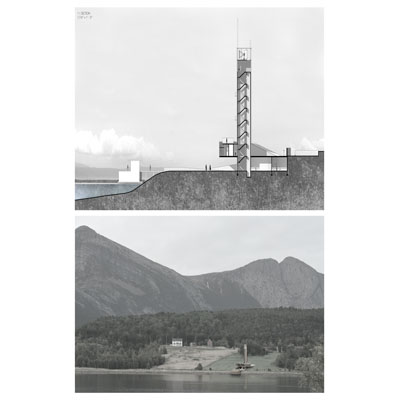
This year, over 400 entries participants submitted work to HERE+NOW: A House for the 21st Century, an international student design competition administered by the Association of Collegiate Schools of Architecture (ACSA) and sponsored by American Institute of Architecture (AIA) and Custom Residential Architects Network (CRAN®). Of the 400 participants, Kang Song (’19), Dan Lu (’19), and Raunak Tibrewala (’19) were awarded first place.
Body
This year, over 400 entries participants submitted work to HERE+NOW: A House for the 21st Century, an international student design competition administered by the Association of Collegiate Schools of Architecture (ACSA) and sponsored by American Institute of Architecture (AIA) and Custom Residential Architects Network (CRAN®). Of the 400 participants, Georgia Tech School of Architecture students, Kang Song (’19), Dan Lu (’19), Raunak Tibrewala (’19), were awarded first prize.
The project titled, “ANOTHER LIFE—Sustaining Iceland’s Family Fishing Economy” looked at the impact of climate change on the fishing industry in Iceland. With an economic imbalance spurred by a shrinking supply of fisheries and a growing tourism industry, Song, Lu, and Tibrewala addressed both matters by designing a hotel and a house.
“The hotel can provide basic services such as accommodation and meals for tourists, and during the fishing moratorium, fishermen can provide tourism services such as guides,” the students noted in their project description.
“The project is elegantly narrated with visually impactful diagrams and drawings,” a juror commented. “The structure offers the potential to serve as an iconic architectural element along the shoreline of an everyday neighborhood. This project demonstrates a level of restraint-responding to the existing context and natural landscape while deftly incorporating public spaces.”
The Design and Research (D+R) Studio, co-taught by Michael Gamble, associate professor and director of the Master of Architecture program and Tarek Rakha, assistant professor of High Performance Buildings, assigned students to tackle the ACSA Zero-Energy Urban Housing Competition proposal.
The design of green infrastructure is a subject near and dear to both Gamble and Rakha’s focus areas. From its beginning, Gamble has been involved in the Kendeda Living Building project, a zero-waste, zero-energy initiative unique to the Southeast.
“Our mission at Georgia Tech is to improve the human condition through progress and service,” said Gamble. “The Living Building and the work coming out of the School of Architecture are clear evidence that Georgia Tech is shaping the future, and our students love it.”
Students from the 2016 Portman Prize Studio actively participated in the Living Building Challenge, which was based on the building's zero-waste building initiative. With topics of sustainability and green infrastructure deeply embedded in the School of Architecture, Gamble and Rakha saw this competition as an opportunity to directly address what they were already teaching in their courses.
“Students in the High Performance Building Master of Science in Architecture program employ state-of-the-art environmental performance simulation tools to inform their partners in architectural design,” said Rakha. “The design and performance integration happen through the use of advanced, research-based frameworks as experiential learning methods that enhance energy and comfort in built environment design.”
In addition to Song, Lu, and Tibrewala winning first place, Solangely Rivera Hernandez (’19), Warren Campbell (’19), and Lu received an honorable mention for their submission “Recovery Assemblies: Rapid Deployable Housing Post-Disaster Events.”
Their project looked at the current protocols provided by disaster relief organizations as people are displaced following floods, hurricanes, earthquakes, etc., and created prototypical, temporary, versatile modules that could be adapted to the needs of the user.